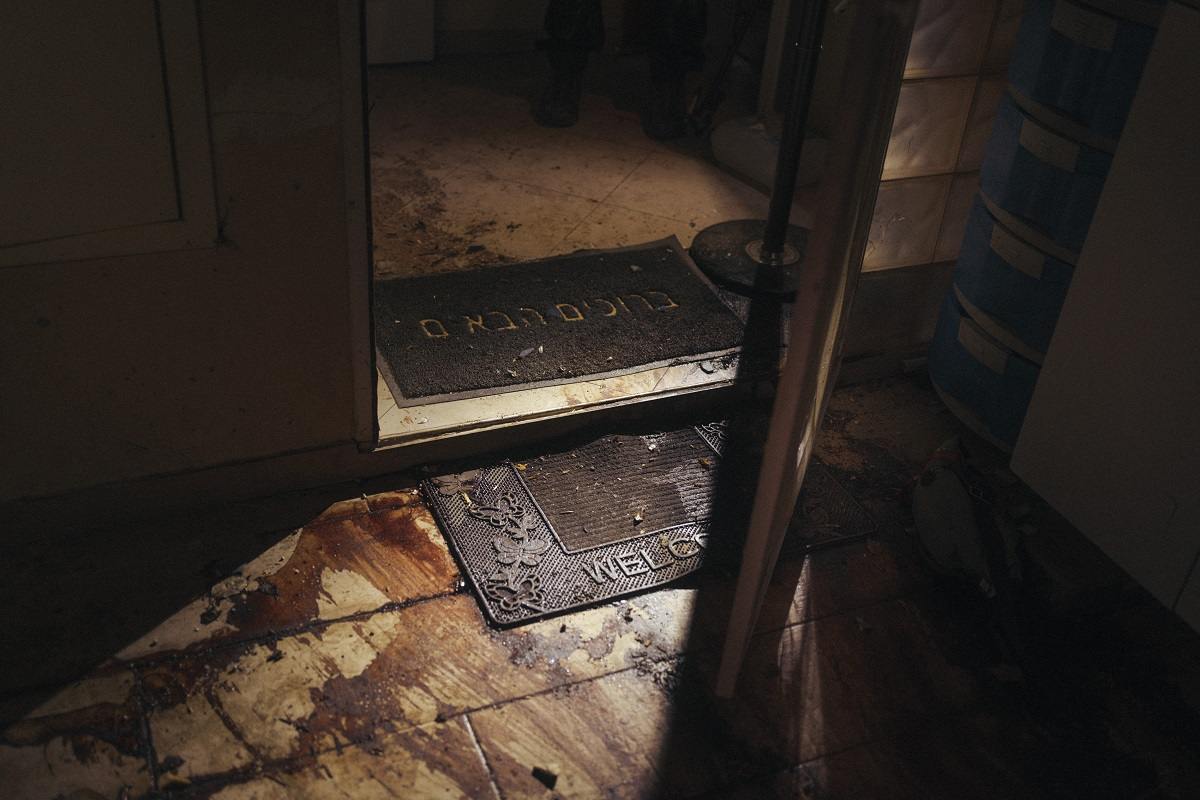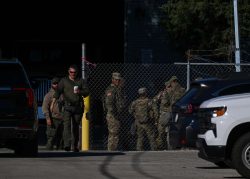
Blood stains the threshold of a house in Kibbutz Be’eri, Israel, after an attack by Hamas and allied fighters on Oct. 7.
13:46 JST, December 14, 2023
The images of the Palestinian men, stripped to their underwear, forced to kneel, some bound, some blindfolded in the custody of Israeli soldiers, were certain to provoke extreme emotions.
When they exploded on social media, similar language across multiple tweets suggested a campaign – organized or spontaneous – to get them to the public.
As photos and video spread on X, Facebook and other platforms last week, they were picked up by Israeli media. “Images circulate of dozens of Hamas terrorists surrendering in Gaza,” the Jerusalem Post trumpeted in a typical headline. Israel’s military, which censors the Israeli media, did not object to the characterization or prevent the images’ spread.
Many in Israel viewed the images as evidence of victory over the militants who rampaged through Israeli communities on Oct. 7, killing 1,200 people. Or righteous vengeance.
Quickly, though, claims that the detainees were Hamas militants were challenged. Palestinians in Gaza identified relatives who they said were not fighters. Some of them were released. The images, rights activists say, began to convey something different, and darker: an attempt to humiliate and dehumanize Palestinians.
This week, the United States, Israel’s closest ally, called the images “deeply disturbing.”
Now they are indelible: an enduring cause for rage among Palestinians and anger in the region. For some, they stir echoes of the tableaus of torture that emerged during the Iraq War from the U.S.-run detention center at Abu Ghraib prison.
“No world leaders asking what’s the fate of Palestinians arrested, stripped, and humiliated by Israeli forces,” Ruba Ali al-Hassani, an Iraqi sociologist, wrote on X soon after the images appeared. “. . . We live in wretched world that repeatedly tells us what it is.”
For some, the public degradation triggered memories of their own ordeals. “You have no idea what this will do to you,” said Mohammad Mattar, 46, a Palestinian man who was detained by Israeli settlers and soldiers in the West Bank in October and was stripped to his underwear and photographed, in images that were posted on social media.
The flood of shocking images from this brutal war began in the hours after Oct. 7, when Hamas and allied fighters attacked soldiers and civilians, including young people attending a rave concert. Pictures and videos showed bodies strewn in fields, houses burned and floors wet with blood.
The Israeli government has been showing video of the assault, some of it taken from the fighters’ cellphones, to foreign journalists and policymakers. Viewers have left the screenings ashen-faced and physically sick.
Depictions of the horrors wrought by the Israel Defense Forces in Gaza have streamed out for weeks, showing the killing of thousands of people, many blown apart by airstrikes. Some show young people, smiling in happier times before they were dismembered and buried in rubble. Some show child survivors trembling, the shock on tiny faces grimed with blood and ash.
The combatants have produced other images. Hamas has released gritty videos of its fighters in urban combat that have circulated widely in the Middle East, where there is broad support for Palestinian resistance to Israel’s occupation.
The militant group also has released hostage videos showing Israelis who were kidnapped on Oct. 7 and taken back to Gaza. “Free, free us now!” one captive demands. “Free their civilians, free their prisoners, free us, free us all, let us return to our families now!”
The Israeli army has shown footage of deadly airstrikes and of tank formations moving freely in Gaza, images that are intended to display battlefield precision and dominance – with no sign of the suffering on the other side of the weapons.
Then there are the videos, apparently recorded by Israeli soldiers, aimed at an audience – in Israel and beyond – clamoring for a win.
These showed soldiers looting shops and homes, a building being blown up, an Israeli flag raised over the bomb-smashed remains of a Palestinian square. None of the images could be independently verified.
IDF spokesman Doron Spielman was asked this month about TikTok videos that a reporter said showed Stars of David spray-painted on the inside walls of Palestinian homes in Gaza and soldiers dancing on beaches in the enclave.
“If they walk around with a can of spray paint, they shouldn’t,” Spielman said. “And if they dance on the beach, you know, I’m not going to go after somebody who’s dancing in the beach.”
Images of one mass arrest were verified by Reuters and the social media verification organization Storyful, which confirmed that they came from Beit Lahia on Dec. 7.
Until recently, videos depicting mass detentions of Palestinian prisoners were rare, said Omar Shakir, the Israel and Palestine director at Human Rights Watch. Israel “has been routinely detaining Palestinians for decades and often mistreating and torturing those in detention,” he said. The organization is investigating the videos.
If the images were published by the Israeli army, as they appeared to be, Shakir said, they could amount to a war crime under international law that prohibits “outrages upon personal dignity.” More videos showing mass arrests have appeared this week.
“How do the majority of Israelis look at it? They are happy about it because they want to humiliate them,” said Gershon Baskin, Middle East director of the London-based International Communities Organization, which works to end conflict.
“Israel feels nationally humiliated about what happened on Oct. 7,” he said. “This is part of the whole revenge mentality.”
But the images are “detrimental to our joint future,” Baskin said, “because at the end of this war, however it ends, there will still be 7 million Jews and 7 million Arabs living in the land between the river and the sea. We have to find a way to live in dignity together.”
The way to do that, he said, “is not to take men and humiliate them in that way. It is stupid.”
“We found those images deeply disturbing,” State Department spokesperson Matthew Miller said Monday. “We are seeking more information both about the nature of the images and of course why they’re public in the first place.”
A senior spokesman for the Israel Defense Forces told The Washington Post that the images “were not released officially by the IDF.” In some photos and video, a soldier’s camouflaged sleeve can be seen, and Hebrew is audible.
“We are trying to understand where these pictures are coming from,” the spokesman said. “There’s no intention to humiliate anyone.”
To protect Israeli troops against Hamas in Gaza, the spokesman said, “the soldiers must be sure that the suspect doesn’t carry a bomb or any kind of weapon under his clothes, as Hamas is very known for doing.” He said Hamas fighters in Gaza often fight in civilian clothes.
“To be asked to take off your shirt, it might not be pleasant, but it’s not the end of the world,” Mark Regev, a senior adviser to Israeli Prime Minister Benjamin Netanyahu, told Sky News last week. The Middle East, he said, was “warmer.”
Unseen in the images are the ordeals that some Palestinians said they endured following their arrests.
Muhammad Salim, 17, was detained this month when Israeli soldiers descended on his neighborhood in northern Gaza. The house was shelled, its inhabitants were rounded up, and the women were separated from the men.
“They demanded we strip down to our underwear,” Salim said, an order he called “humiliating.” Salim and his relatives were blindfolded, bound with plastic ties and led to a storage room under a house. In time, they were moved to another area and questioned.
Later, in a warehouse, he said, the men were “subjected to degrading treatment.” Soldiers cursed and kicked them, struck them with rifle butts and poured urine over them, he said.
Those detainees who, like Salim, were under 18 were “subjected to lighter beatings,” he said.
“They would laugh, scream, sing and dance while simultaneously inflicting harm on us,” he said. They were held for four or five days in Gaza, he said, and then taken to Israel. There were more beatings along the way, he said. His father, a diabetic, went without his insulin for days, he said.
Salim’s account could not be independently corroborated.
Of 150 men who were arrested, he said, only 1o, including himself, have been released.
Mattar, the activist who was arrested in the West Bank in October, called his detention a “brutal and terrifying thing.”
“For a whole month I was unable to get out of this psychological trauma that I fell into, as a result of what the occupation army and the settlers did toward me, from beating me, taking off my clothes,” he told The Post.
“I will never recover from it.”
"News Services" POPULAR ARTICLE
-

American Playwright Jeremy O. Harris Arrested in Japan on Alleged Drug Smuggling
-

Japan’s Nikkei Stock Average as JGB Yields, Yen Rise on Rate-Hike Bets
-

Japan’s Nikkei Stock Average Licks Wounds after Selloff Sparked by BOJ Hike Bets (UPDATE 1)
-

Japan’s Nikkei Stock Average Buoyed by Stable Yen; SoftBank’s Slide Caps Gains (UPDATE 1)
-

Japanese Bond Yields Zoom, Stocks Slide as Rate Hike Looms
JN ACCESS RANKING
-

Tokyo Economic Security Forum to Hold Inaugural Meeting Amid Tense Global Environment
-

Keidanren Chairman Yoshinobu Tsutsui Visits Kashiwazaki-Kariwa Nuclear Power Plant; Inspects New Emergency Safety System
-

Imports of Rare Earths from China Facing Delays, May Be Caused by Deterioration of Japan-China Relations
-

University of Tokyo Professor Discusses Japanese Economic Security in Interview Ahead of Forum
-

Japan Pulls out of Vietnam Nuclear Project, Complicating Hanoi’s Power Plans
























